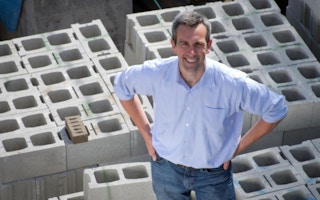Carbon dioxide, along with other greenhouse gases, is a contributor to global warming, but one company has found a way to use it in concrete production such that it now contributes to carbon reduction instead.
To continue reading, subscribe to Eco‑Business.
There's something for everyone. We offer a range of subscription plans.
- Access our stories and receive our Insights Weekly newsletter with the free EB Member plan.
- Unlock unlimited access to our content and archive with EB Circle.
- Publish your content with EB Premium.
CarbonCure Technologies, a clean-tech company based in Halifax Nova Scotia in Canada, has devised a way to inject carbon dioxide into the production of concrete blocks. According to the firm, this not only helps cement and concrete manufacturers to create a significantly green building material, but it also addresses the wider concern of global emissions reduction.
The firm, which started to attract attention in 2012, uses the concept of carbon capture and storage (CCS) in its CarbonCure system. The patent-pending technology takes carbon dioxide waste, such as those from large emitters like refineries and fertilizer plants, and mixes it into the concrete during the production phase. The chemical reaction that happens, the firm explains, is a reversal of the process used to make cement, a key ingredient in concrete.
Cement represents about five per cent of anthropogenic global carbon dioxide emissions, according to a 2009 report by the International Energy Agency (IEA).
“
It’s that triple-win [of stronger, cheaper and green] that makes it really attractive to producers
Robert Niven, CarbonCure Technologies founder
“If you look at concrete, cement starts off as CaCO3 [or solid limestone], it’s heated in cement kilns, and this releases one molecule of CO2 for every molecule of lime. We’re reversing that reaction – we’re providing a supplementary curing reaction,” said Robert Niven, founder of CarbonCure Technologies in recent report by environmental website TreeHugger.
As a result, concrete manufacturers that have been retrofitted with this technology are able to produce concrete blocks that are stronger, cheaper and green, said Niven to The Financial Post. “It’s that triple-win that makes it really attractive to producers,” he added.
The firms are also able to manufacture the construction material using less energy, while those in the building industry who opt to use it can receive credits in green building certification programs like LEED, note CarbonCure.
However, the biggest advantage of the technology, the company points out, is that “100,000 grey blocks absorb the same amount of CO2 as 92 full grown trees will absorb in a year”. They added that more carbon dioxide is captured than is emitted during the manufacture and transport of these CarbonCure blocks, reducing emissions by up to 20 per cent.
Carbon capture and storage, also referred to as carbon sequestration, was highlighted in the latest Working Group III report of the Intergovernmental Panel on Climate Change (IPCC), which focused on climate change mitigation across different emissions scenarios. CCS was mentioned alongside the need to increase deployment of renewable energy and bioenergy.
Niven said the amount of emissions reduction per building may vary depending on the quantity of blocks used, but the potential is there as three billion blocks are produced annually in North America alone. In addition, “the North American market for concrete blocks and bricks is projected to increase to 4.3 billion units per year by 2014,” Hilal El-Hassan and Yixin Shao noted in their study on “Carbon Storage through Concrete Block Carbonation Curing”.
But beyond this region, he has plans to enter the BRIC markets: Brazil, Russia, India and China. The company’s goal is to eventually have every concrete block and building in the world made with their technology, he said.








